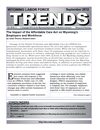
Wyoming Jobless Rate Increases to 5.6% in July 2012
The Research & Planning section of the Wyoming Department of Workforce Services has reported that the state's seasonally adjusted1 unemployment rate increased from 5.4% in June to 5.6% in July (not a statistically significant change). July was the second month in a row that Wyoming's jobless rate has increased. However, the state's unemployment rate was somewhat lower than its July 2011 level (6.0%) and significantly lower than the current U.S. unemployment rate (8.3%). Seasonally adjusted employment of Wyoming residents fell by 1,728 individuals (-0.6%) from June to July.
From June to July, most county unemployment rates followed their normal seasonal pattern and decreased slightly. Employment tends to increase in July, with seasonal job gains in construction, professional & business services, leisure & hospitality, and other sectors. The largest decrease in unemployment occurred in Teton County, where the jobless rate fell from 5.1% in June to 4.1% in July. Jobless rates increased slightly in Big Horn (up from 6.5% to 6.7%), Fremont (up from 6.9% to 7.0%), and Lincoln (up from 7.1% to 7.2%) counties.
The lowest jobless rates in July were found in Sublette (3.6%), Teton (4.1%), Hot Springs (4.3%), Converse (4.3%), and Campbell (4.3%) counties. Lincoln County posted the highest unemployment rate (7.2%). It was followed by Fremont (7.0%), Big Horn (6.7%), and Sheridan (6.2%) counties.
From July 2011 to July 2012, unemployment rates fell in 14 counties, increased in 6 counties, and were unchanged in 3 counties. Teton County reported the largest decrease, falling from 4.8% to 4.1%. Sizeable decreases were also seen in Hot Springs (down from 5.0% to 4.3%), Natrona (down from 5.6% to 5.0%), and Johnson (down from 6.2% to 5.6%) counties.
Total nonfarm employment in Wyoming (measured by place of work) fell from 294,700 in July 2011 to 293,900 in July 2012, a decrease of 800 jobs (-0.3%; not a statistically significant change).
1Seasonal adjustment is a statistical procedure to remove the impact of normal regularly recurring events (such as weather, major holidays, and the opening and closing of schools) from economic time series to better understand changes in economic conditions from month to month.

(r) Revised.
(p) Preliminary.
